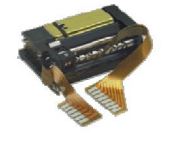Replacing the Thermal Printer in a Sage-Endec – and Other Fixes
[August 2010] As with more printers, those in most EAS receivers have a finite lifespan. If yours has not failed as yet, it might be a good idea to be prepared – it might just be ready to happen. After all, many of these receivers have been in use for as long as 14 years.
While many of the newer EAS receivers have ports to either connect to your LAN or to save all the data to USB flash drives so the data can be saved and/or printed as desired, you may not yet be ready to invest in a new receiver. So, replacing the printer may be the right solution for you.
Basically what usually happens is that the printers start to lose their traction to pull paper – or they just plain give up after a paper jam. Fortunately, replacing the printer with an OEM replacement printer module is pretty easy.
A 15 Minute Job
It only takes a Phillips screwdriver and about 15 minutes to do the job.

The print head is manufactured by Seiko and can be purchased from DM Engineering for $57.00. The replacement printer module comes with step-by-step instructions and a troubleshooting guide to make it easy.
You can preview the troubleshooting guide by clicking here.
Is Replacement the Best Solution?
Some receivers have already gotten a replacement printer, and at those times, it is common for engineers to consider if there are other useful solutions – perhaps something with a better (non-thermal) paper output. For example, some stations use an outboard printer, occasionally pressing into service an old printer that was sitting in storage.
On the other hand, while a standard printer with regular paper and an ink ribbon usually will provide a clean, clear printout, there are a few issues to balance when deciding to go this route.
First of all, using an old printer might just bring back the problems that caused it to be put in storage in the first place. Then there is the issue of the serial output of most legacy EAS receivers. It will take a serial to parallel or serial to USB converter to make the connections. And ribbons might be hard to acquire – or are expensive – for older printers.
Finally, just where do you put a bulky printer in a tightly filled rack?
The answer for many, especially if they plan to keep the Endec and add a CAP decoder to it is to replace the printer module and have a well-operating unit.
Do Not Forget the Battery
By the way, if you have not replaced the lithium memory cell within the last umpteen years it would be a good time to do it as you replace the printer.
The cell number is CR2330 and it is a 3 Volt disk type that snaps into its holder in the left front corner of the main PCB. They are available at many drug stores, parts houses, as well as Radio Shack, Mouser Electronics, and Digi-Key.
One note: you will need to re-program the Endec afterwards, so some folks decide to wait until it fails to do it. Still, it may be better to be proactive for a number of reasons – including Murphy ensuring it will fail during a holiday weekend (!) – than to find your Endec failing when you really need it.
… And the Power Supply, Too!
Take a moment to consider the power supply as well. The wall wart that powers the Sage Endec is a well-known source of problems. As the capacitor dries out, it loses the ability to provide clean DC voltage and the ripple causes repeated reboots of the receiver. In the worst cases, it happens during an EAS test, preventing the EOM from being sent, and locking up other stations.
While replacing the wall wart’s internal capacitor will restore the power supply, most of the LP stations have, by now, completely replaced their wall warts with a power supply capable of at least 13.8 Volts at 1.7 Amps or better. Bottom line, if your receiver goes into periodic reboots, it is time for you to do so as well.
With these tips, you can keep your EAS receiver working well.
– – –
Additional information is available at http://www.dmengineering.com, or at the URL above.
